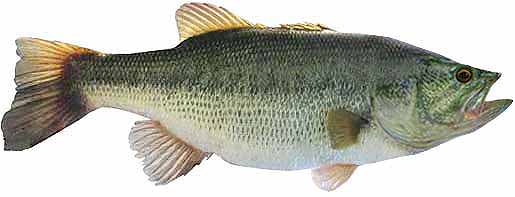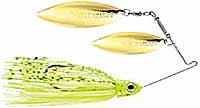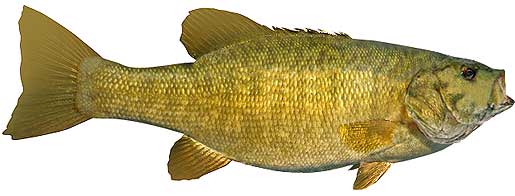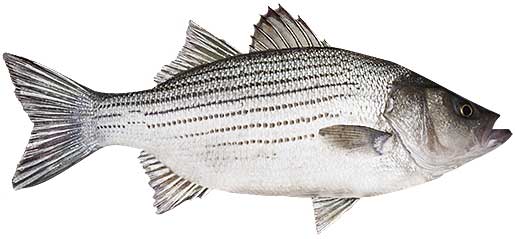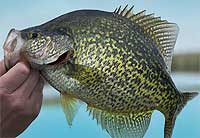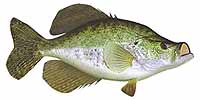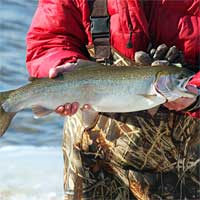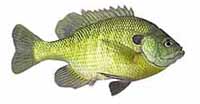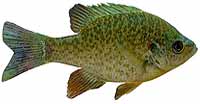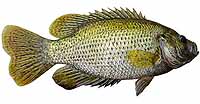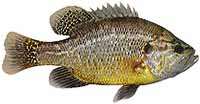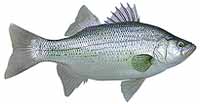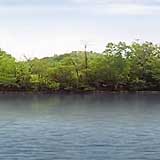Fishing Report For Fort Patrick Henry Lake, TN
By Rick Seaman
October 1, 2025
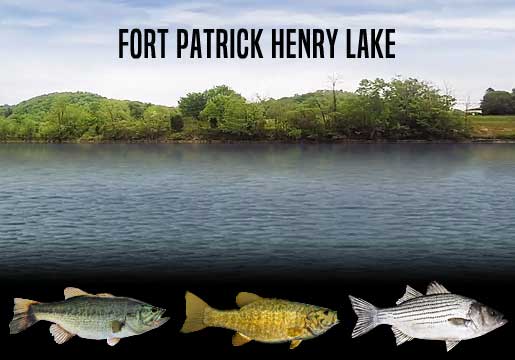
Fishing Reports
Popular Fish Species Fort Patrick Henry Lake, TN
Largemouth Bass
Current Report: Good To Very Good
FALL. Now that Fall has arrived, bass here are moving shallow and following schools of baitfish into coves and shallow bays around 4 to 10 feet deep. While it's not a trophy lake, it's quite good for numbers. Currently topwater, jerkbaits, crankbaits, and slow-rolled spinnerbaits are catching most of the bass. Current water temperatures are in the low 70's. Later in Fall, as deeper water cools, bait and bass move out to ledges, channel edges, points and humps where flutter spoons and jigs are often good choices.
WINTER. Winter will isolate them around slightly deeper structure, flats, points and creek channels. They can be found from 10 to 20 feet deep. Here they hold, feeding less frequently, awaiting warmer water to return in Spring.
SPRING. Once water temperatures rise into the low 60's, largemouth will move from deep wintering holes, to shallower water nearby spawning areas. Vibrating jigs, jerkbaits and spinnerbaits typically get bites just away from the shoreline. At this time they are feeding aggressively and preparing for the spawn. Once water warms into the mid to high 60's, they will move into 2 to 8 feet of water, and create nests, then lay their eggs. Immediately afterwards, females move to deeper water and males remain to guard the eggs, and then the fry. After a couple weeks, the males also move to slightly deeper water. Crankbaits, vibrating jigs, plastic worms and swimbaits are catching bass in 5 to 10 feet of water, during this period.
SUMMER. Water temperatures will warm considerably in Summer. Bass will feed shallow, early and late in the day, where they will be caught on topwater, crankbaits and swimbaits. Wacky-rigged stick worms always catch finicky bass when the bite is slow. Largemouth bass here feed on gizzard shad, threadfin shad, small sunfish and crawfish. During the hotter parts of the day, they are being caught on points, channel edges, and ledges 10 to 15 feet deep.
Smallmouth Bass
Current Report: Good
FALL. As Fall arrives, smallmouth here follow schools of baitfish into coves and bays 8 to 15 feet deep. This is when jerkbaits, deep-diving crankbaits, and slow-rolled spinnerbaits, are quite successful. The average fish being caught averages about 1 3/4 pounds, but plenty of 3 pound smallies are often caught. Fishing shallow for smallmouth is often good on cold, windy, cloudy and rainy days.
WINTER. Winter will isolate them around deeper structure, points and creek channels, often suspending in open water above these features. They can generally be found from 12 to 20 feet deep. Here they hold, feeding less frequently, awaiting warmer water to return in Spring.
SPRING. When water temperatures rise into the 50's now, smallmouth have moved from deep wintering spots to shallower water, just outside spawning areas. They feeding heavily in 4 to 12 feet of water at this time, and are typically caught on jerkbaits, crankbaits, tube baits, Ned rigs, and crayfish imitating plastics. Once water warms into the high 50's, they move into shallower water, and create nests in gravel or sand areas, then lay their eggs. Females then move to deeper water and males remain to guard the eggs, and then the fry. After a couple weeks, the males also move to around 20 feet deep, and feed aggressively - both shallow and off shore. Crankbaits, tube baits, Ned rigs, plastic worms, spoons and swimbaits are catching smallies during this period.
SUMMER. Smallmouth bass will be currently feeding shallow early and late in the day, where they are being caught on topwater, crankbaits, swimbaits, Ned rigs and tube baits. Smallmouth bass here feed on crawfish, threadfin shad, gizzard shad, herring and small sunfish. They prefer rocky or gravel bottom areas, as this is where crayfish live. During the hotter parts of the day, they are being caught on points, humps, and ledges 12 to 20 feet deep. Often these deeper fish are part of a school of smallies.
Hybrid Striped Bass
Current Report: Fair To Good
FALL. In Fall, hybrid stripers return to shallow water, the upper end of the lake, and into inflowing water if available. Early in the day wipers chase bait to the surface and feed aggressively, making this an excellent time for topwater action. Look for 8 to 20 feet of water nearby deeper sections along the river channels, and fish them thoroughly. Most any lure that resembles shad will catch wipers at this time of year.
WINTER. In Winter, hybrid stripers again hang out in deeper water and feed close to the bottom, often 20 to 30 feet deep, or deeper. Warm afternoons occasionally draw stripers shallower, so look for them around the 10 to 20-foot range as they feed on roaming schools of threadfin shad, herring and gizzard shad. In Winter it is important to locate schools of bait, then look for wipers schooling below the bait. Fish finders, and forward facing sonar, are a big help in locating these roaming schools. Nice fish are being caught while trolling or drift fishing. Spoons, swimbaits, blade baits, crankbaits, live bait and cut bait are typically effective this time of year. Due to slower metabolism, anglers typically trigger more strikes by making slower presentations.
SPRING. When water temperatures rise into the mid 60's now, it's the ideal time for hybrid stripers to spawn. There are plenty of hybrids averaging 2 to 4 pounds, with an occasional 8-pound plus fish being caught. In Spring, work the points and creeks, and upper end of the lake if there is inflowing water. If they spawn, they will lay eggs in flowing water. Look for deeper holes in the river channels, as they are a good holding place for hybrid stripers after the spawn. On the main lake, focus on 8 to 20 feet of water.
SUMMER. In Summer, these wipers typically hang out in 15 to 30 feet of water, staying close to schools of bait. Sometimes during the heat of the day they move close to the bottom, 40 feet deep or deeper. Morning often draws hybrid stripers to much shallower water, so look for them around the 10 to 20-foot range as they feed on shallow, roaming schools of threadfin shad, herring and gizzard shad. Being successful at fishing for stripers in Summer is a matter of locating schools of bait, and the wolf packs of wipers are likely to be nearby. Fish finders, and sonar electronics, are a big help in locating these roaming schools. Nice wipers are being caught by casting, trolling or drift fishing. Spoons, blade baits, crankbaits, live bait and cut bait are all effective here.
Fishing Video
Fish species to fish for...
Guide to fishing for largemouth bass, smallmouth bass, spotted bass, channel catfish, flathead catfish, black crappie, white crappie, rainbow trout, brown trout, bluegill, redear sunfish, rock bass, warmouth, white bass, striped bass and hybrid striped bass at Fort Patrick Henry Lake in Tennessee.
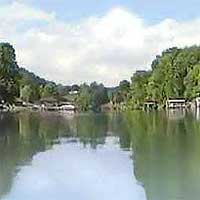
Fort Patrick Henry Lake is an 872-acre lake with about 70 miles of shoreline. Bank fishing is available at numerous locations around the lake. Largemouth bass, smallmouth bass and hybrid stripers are popular species here. In addition the lake has spotted bass, crappie, catfish, trout, sunfish, white bass, striped bass, and others.
Primary fish species to catch
Click images for fishing tips and details about each species.
Today's Weather & Forecast
Public Boat Launch Ramps & Landings
Click here for boat ramps.
Fishing License
Click here for a Tennessee Fishing License.
Map - Fishing & Access
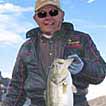
Rick Seaman is a fishing enthusiast with over five decades of fishing experience, a retired tournament fisherman, author of numerous published articles on fishing, and co-author of the book "Bass Fishing - It's not WHAT you throw, It's WHERE you throw it".
Contact Information
Warrior's Path State Park
490 Hemlock Rd,
Kingsport, TN 37663
423 239-8531
Fishing lakes in each state
100125
Ft Patrick Henry Reservoir, TN Report
TENNESSEE


Prime bass, striper and trout fishing in northeast TN.


